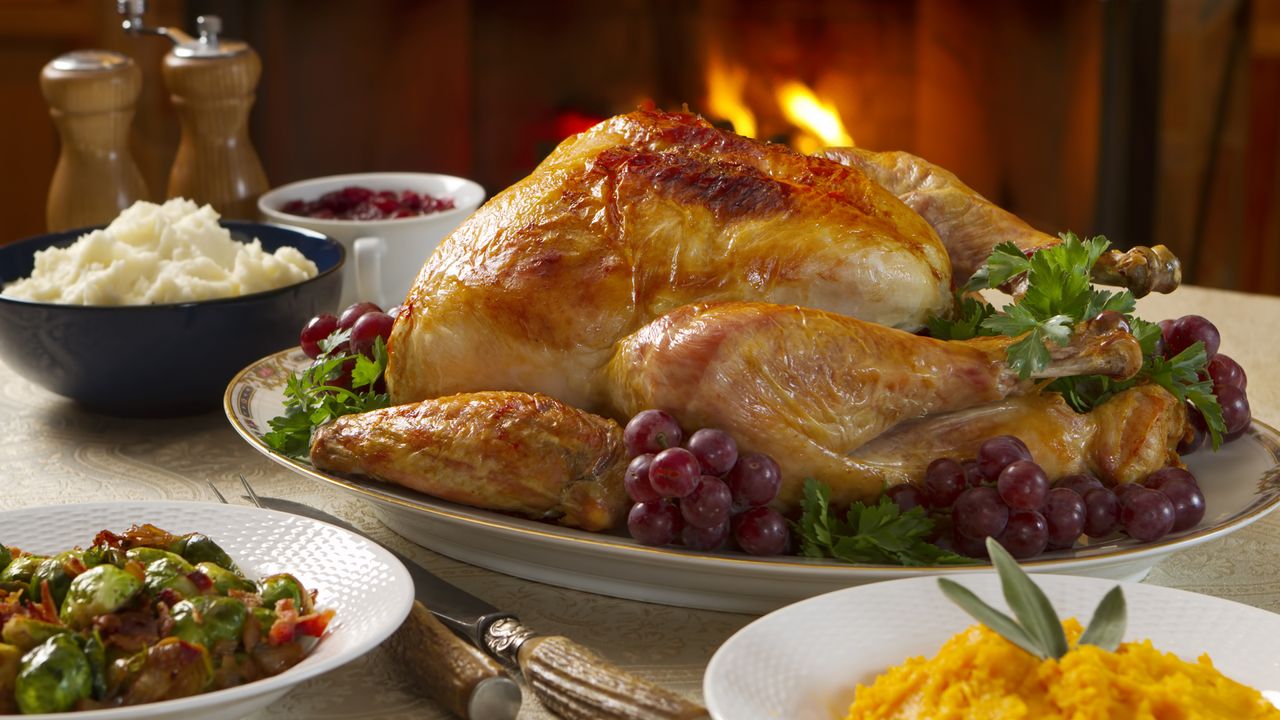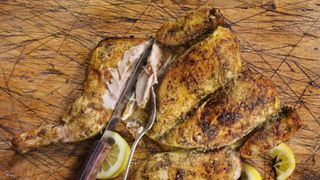
As the centrepiece of the Christmas dinner table, the turkey is the chief bringer of nightmares for novice cooks. 9 out of 10 people bemoan that turkey is dry and flavourless, yet we still keep buying and eating them, once a year without fail.
Cooking a turkey is all about keeping it moist and juicy; for that you’ll need fat, but what sort of fat you use is up to you. Butter is most traditional – favoured by Delia, who smears it over the bird then bastes regularly. Nigel Slater goes for goose fat – somewhat controversial but if you’re already using it for your roasties, it might be a more efficient option.
• Best Boxing Day sales – you are sure to find your next roasting tin, the best saucepan set or the perfect non-stick pan here
Combining butter and bacon provides a double whammy of fat to keep the turkey nice and moist during cooking, and adds great flavour at the same time. Just remember to baste the turkey regularly and all will be well.
Here we bring you a simple turkey recipe that is as quick and easy as possible, and a more advanced recipe for those who favour BIG flavour. The latter method is also extremely quick (by turkey standards), so could be a winner if the day has rushed past you in a blur, and all you've had to 'eat' is 11 snowballs and a bottle of red.
Easy Christmas turkey
SERVINGS: 6 (4 + leftovers)
Time: 3 hours
Sign up to the T3 newsletter for smarter living straight to your inbox
Get all the latest news, reviews, deals and buying guides on gorgeous tech, home and active products from the T3 experts
Ingredients
4kg (9lb) turkey, giblets removed
150g (5oz) streaky bacon
80g (3oz) butter, softened
1 bundle of hard herbs (rosemary, thyme, bay leaf), tied with string
½ lemon
½ garlic bulb
2 onions, halved
Salt
Method
Preheat your oven to 180ºC (360ºF). Take your turkey out of the fridge an hour before you are ready to cook, so it has time to come to room temperature.
Season the turkey generously with salt, both inside the cavity and out. Smear the butter all over the bird, then lay the streaky bacon across the breast in a neat layer. Put the half lemon, garlic and hard herbs into the cavity.
Pour half a centimetre of boiling water into the bottom of a large roasting tray, then place onion halves cut-side down and arrange so that the turkey sits on top – this lifts the turkey out of the water, but the steam will help to keep the bird moist. Cover the roasting tin with tin foil.
Roast the turkey for 2 hours. Check the bird every half an hour and give it a good baste with the juices.
After 2 hours, turn the oven up to 200ºC (400ºF). Remove the foil from the roasting tin, and remove the bacon from the turkey. Baste again, and roast the turkey for another 30 minutes to crisp up the skin.
A meat thermometer is the most foolproof way to make sure the turkey is done – you’re looking for an internal temperature of 70ºC (160ºF). Alternatively, you can insert a skewer into the thickest part of the leg and check the juices – if they’re clear, your turkey is cooked through. Let it rest for at least half an hour, preferably 45 minutes before you carve.
Spatchcock roast turkey with Madeira sauce

Here, we are going to spatchcock the turkey – cutting out the backbone with a big pair of scissors, to put it in less technical language. This means it cooks much faster.
SERVINGS: 6
TIME: 1 hour 30
Ingredients
4kg (9lb) turkey, giblets removed and reserved
2 tbsp fine sea salt
1 tsp ground black pepper
2 onions, quartered
2 carrots, peeled and roughly chopped
2 celery sticks, roughly chopped
5 garlic cloves, in their skins
1 bay leaf
A few sprigs rosemary
A few sprigs thyme
Olive oil
1 tbsp plain flour
150ml (2/3 cup) Madeira (or dry sherry)
500ml (2 cups) turkey or chicken stock
2 tbsp cider vinegar
Method
First, prep your turkey. Start by cutting out the wishbone – this will make it much easier to carve. Take a small, sharp knife and free the v-shaped wishbone from the breast meat at the neck end, twisting to remove.
To spatchcock the turkey, take a solid pair of kitchen scissors and cut down either side of the backbone to remove it. Flatten the turkey so the breasts and legs face upwards.
Combine the salt and pepper, and generously season both sides of your turkey. You can loosen the skin and rub some of the salt mixture directly onto the meat if you want to. You might not need all of the salt mix depending on the size of your turkey!
Store the turkey in the fridge, loosely covered with cling film.
When you’re ready to cook, preheat your oven to 220ºC (430ºF). Take your turkey out of the fridge an hour before you are ready, so it has time to come to room temperature.
Put the onions, carrots, celery and garlic in a large roasting tin, along with the herbs, the reserved giblets and backbone, and a splash of water (just enough to cover the bottom of the tin). Lightly season the vegetables, then place the turkey on top. Splash some olive oil over the turkey and rub it over the skin.
Spatchcocking the turkey means it cooks way quicker. So roast the turkey for around 45 minutes, checking occasionally to see if it needs turning or if you need to add another splash of water to the pan (this will stop the vegetables from burning).
Consult a meat thermometer to check that the turkey is done – you’re looking for an internal temperature of 70ºC (160ºF). Alternatively, you can insert a skewer into the thickest part of the leg and check the juices – if they’re clear, your turkey is cooked through.
Remove the turkey and rest for half an hour. Meanwhile you can make a quick sauce in the pan.
Make a paste with the flour and a spoonful of the fat in the roasting tin, then return the paste to the roasting tin and put the tin over a medium/high heat. Cook out the flour paste for a minute, then add the Madeira and reduce for 5 minutes. Now add the stock and reduce for another 15-20 minutes until the sauce has good flavour and a syrupy consistency. Add the cider vinegar, then strain and keep warm.
Carve the turkey and serve with the sauce. Bon apetit!
And now it's time to shop…
- Amazon Boxing Day sale: huge savings in every department
- Argos Boxing Day sale: save on toys, games, and home and garden items
- ASOS Boxing Day sale: up to 70% off clothes, and an extra 15% for new customers
- Boots Boxing Day sale: save up to 1/2 price on 1000s of items
- Currys Boxing Day sale: save up to 40% on over 1,000 products
- Halfords Boxing Day sale: up to 25% off in-car technology
- Harrods Boxing Day sale: save up to 50% on designer clothing
- H&M Boxing Day sale: 50% off online and in store
- John Lewis Boxing Day sale: up to 70% off now across the store
- Lovehoney Boxing Day sale: up to 50% off sex toys and lingerie
- Made.com Boxing Day sale: save up to 40% on furniture and homewares
- Marks and Spencer Boxing Day sale: up to 50% off clothes and household goods
- Next Boxing Day sale: 16,000 items half-price or less
- River Island Boxing Day sale: up to 50% off fashion for women, men and kids
- Simba Boxing Day sale: 35% off mattresses
- Wayfair Boxing Day sale: save on furniture, lighting and more
Pete started his fledging journalistic career covering lifestyle tech and video games for T3, before a brief sojourn in food turned into a full time career as a chef, recipe developer and editor with the likes of Great British Chefs, BBC Food and SquareMeal. Over a decade later he has come full circle, putting kitchen tech and appliances through rigorous testing for T3 once again, and eating a quite intense number of omelettes whilst testing non-stick pans. In his spare time Pete loves nothing more than squashing his size 11 feet into tiny shoes and going climbing. He also dabbles in cricket writing from time to time, and is certainly a man who knows his leg from his wicket.

